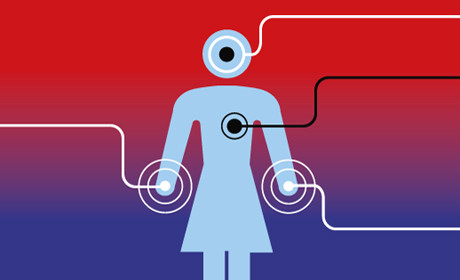
When you consider wearable technology, it's likely that you'll think of Google Glass, a fitness tracker or a smartwatch, depending on your day to day activities.
You might use a smartwatch to read the news or track how many miles you've run in a day, but generally, people acquire such devices for leisure and personal use.
However, some companies have started experimenting with wearable devices beyond consumer purposes, using them to track their employees' performance at work.
Chris Brauer, a professor at Goldsmiths University, has been conducting studies focusing on wearables in the workplace and the correlation this may have with people's performance and productivity.
Based on his work, Sarah O'Connor, employee correspondent at the Financial Times, started working on a feature about the benefits and privacy issues surrounding wearables in the workplace.The fact that we told people what we were doing and what we were up to...was quite helpful in terms of gathering interesting material about the topicSarah O'Connor, employment correspondent, FT
But she decided to take her reporting one step further and not only wear them herself, but give readers daily updates on her progress.
"I thought this might give me a chance to find out more about how it actually feels to be an employee wearing all this stuff and whether or not it changes the way you feel about your job, your boss or yourself," O'Connor told Journalism.co.uk.
The FT's Wearables at Work Facebook page gathered more than 1,000 likes during the four days of the experiment.
Readers actively engaged in conversation with O'Connor, often leaving comments about how interesting the experiment had been and how it had made them aware of the implications of wearable technology.
"The fact that we told people what we were doing and what we were up to meant lots of people approached me and said 'oh actually, I know this about something that's happening here' or 'talk to this company that's doing this sort of thing' – it was quite helpful in terms of gathering interesting material about the topic," O'Connor said.
Live-streaming apps like Periscope now let audiences go behind the scenes of reporting, giving them insight into stories or events and enabling them to share an experience together.
By choosing Facebook to host the progress of the experiment, the FT achieved a similar connection with their readers.
"We wanted to see if we could build an audience for a story by opening up our reporting process," said Robin Kwong, an interactive data journalist at the FT and one of the project's managers.
He explained they initially decided to publish the updates via a "week-long, running liveblog", but decided it was more practical to use Facebook as the primary publishing platform and "bring the content back onto the FT's site using Storify."
Facebook was more suitable for the project due to its ability to handle and store multimedia content, send push notifications to followers, provide analytics to track each post and allow publishing from a mobile device when O'Connor was out in the field.
The apps gave an insight into O'Connor's research of the story
Another reason was a "desire to go to where our audiences are". According to Kwong, the FT's biggest social media presence is on Facebook and Twitter, so the choice was between the two platforms, rather than Snapchat, Pinterest or Periscope, where the FT has a smaller presence.
In the days before and after the experiment, O'Connor regularly posted useful articles about wearable technology, short videos of herself wearing the devices and the conversation she and her boss had when the project concluded.For me, the most interesting aspect is... how engagement can help journalists find better stories and do better reportingRobin Kwong, interactive data journalist, FT
According to Kwong, the tips, anecdotes and advice she received from readers "are now a resource that she can use in future stories."
He hopes the FT's project can inspire other newsrooms and pointed to NPR and ProPublica's audience engagement strategies for inspiration.
"For me, the most interesting aspect is not so much how news organisations could use engagement to build more fervent audiences, but how engagement can help journalists find better stories and do better reporting."
Free daily newsletter
If you like our news and feature articles, you can sign up to receive our free daily (Mon-Fri) email newsletter (mobile friendly).
Related articles
- What the Financial Times learned from experimenting with AI
- Keeping the conversation clean: How AI helps the Financial Times moderate comments
- Five key takeaways from the UK select committee on the future of news
- From Reuters to The New York Times, Big Oil pays 'most trusted media brands' to push greenwashing
- How the Financial Times is broadening its portfolio











